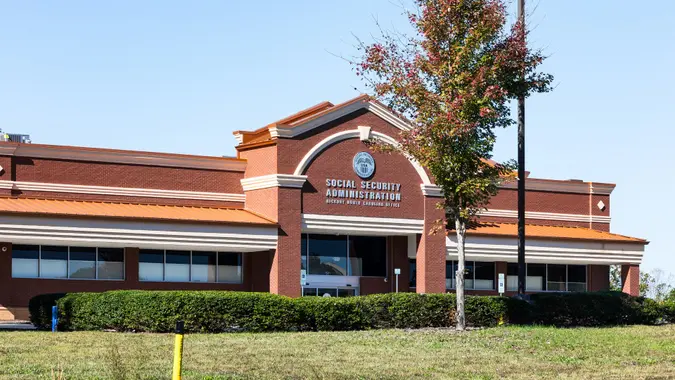I’m a Financial Advisor: Why You’re Probably Wrong About Social Security Cuts

Commitment to Our Readers
GOBankingRates' editorial team is committed to bringing you unbiased reviews and information. We use data-driven methodologies to evaluate financial products and services - our reviews and ratings are not influenced by advertisers. You can read more about our editorial guidelines and our products and services review methodology.

20 Years
Helping You Live Richer

Reviewed
by Experts

Trusted by
Millions of Readers
It has been just a little over 40 years since the last time Social Security was reformed.
The system was in trouble: If action wasn’t taken by the spring of 1983, the program’s Old Age and Survivors Insurance (OASI) Trust Fund would start running a deficit. It wasn’t an existential threat necessarily, but at the very least it would have disrupted benefits starting that summer.
A bipartisan commission appointed by President Ronald Reagan put together a $168 billion package that was swiftly passed by Congress and signed into law in April 1983, and Social Security continued without major disruption.
In early 2023 though, the Social Security Board of Trustees released a report predicting that unless action was taken, the program’s trust fund reserves — the OASI and the Disability Insurance (DI) fund — would be depleted by 2033.
Though that’s an alarming statement to hear, there’s more nuance to the situation that may ease some concerns. Here’s what you might have wrong about cuts to Social Security.
Social Security Might Be in Trouble Again
Is this report saying Social Security would go bankrupt? Not exactly.
Martha Shedden, president and co-founder of the National Association of Registered Social Security Analysts, said, “Social Security cannot ‘run out of money.’ Money is continuously being paid into the trust funds by those who are currently working, and those funds are providing the current benefits for retired, widowed and disabled individuals.”
That doesn’t mean there wouldn’t be a negative impact. If no action is taken by policymakers, there would be disruptions to benefits if the trust funds did become totally depleted.
“Payments estimated at 75% to 80% of promised benefits would only happen if absolutely no changes are made to increase the income and/or decrease the spending from the trust funds,” Shedden continued.
Why Cuts Are Unlikely
It’s important to understand that these predictions, while alarming, are far from guaranteed; they will come to pass only if U.S. policymakers fail to take any action to address the problem. That probably won’t happen, in large part because of just how important Social Security is to the American public.
Amy Colton, financial advisor and founder of Your Divorce Made Simple, said, “Currently, 179 million Americans rely on it, and it constitutes 40% of retiree income. The poverty rate among seniors remains below 9.5%, primarily due to this safety net. Additionally, a significant number of older individuals, approximately a third of those aged 55 or more, have less than $25,000 in retirement savings.”
Those figures make it pretty clear that the program is a critical lifeline to a huge portion of the country, and a Congress with approval ratings in the low 20s isn’t exactly in a position to ignore that. The good news is that there are a lot of options to keep Social Security secure.
“Social Security has many rules, criteria and calculations that cover all facets of the program,” Shedden said. “These make it complicated and misunderstood but also provide us with the opportunity to make the changes needed. Even small combinations of changes from several of the possibilities can extend the longevity of the program for decades.”
What Could Change
It’s pretty obvious, then, that some action will be taken — but what exactly?
“Potential adjustments could include shifting the full retirement age from 67 to 70, or perhaps making all earnings subject to Social Security tax,” Colton said. “But these potential alterations should not be viewed as ‘cuts,’ but rather as necessary evolution for the program’s long-term survival.”
Some legislators already have tried to get the ball rolling. In February of this year, Sen. Bernie Sanders, along with several fellow members of Congress, introduced a bill called the Social Security Expansion Act. It would ensure Social Security was funded for an additional 75 years and also increase retiree benefits by $2,400 a year. The bill has not yet advanced past the Senate Finance Committee.
While the exact future of Social Security may not be clear yet, some sort of action surely will be taken — given its popularity and importance to the American public.
As Shedden said, “For 88 years Social Security has been successful at lifting millions of people out of poverty, providing for disabled workers and surviving family members and offering basic healthcare to elderly. Just as in 1983, a truly bipartisan group of legislators are needed to tackle and solve this problem. The sooner, the better.”
More From GOBankingRates
 Written by
Written by  Edited by
Edited by 
























